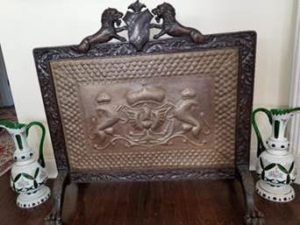 KO sent me a photo of a fireplace screen he lived with for 65 years. He wants to know who owned it originally. Perhaps the family was noble?
KO sent me a photo of a fireplace screen he lived with for 65 years. He wants to know who owned it originally. Perhaps the family was noble?
The screen is made of copper, pounded to create a relief from the back, a technique called repousse. We call the design heraldic with figures in the style of a family crest. The school of the study of heraldry includes related disciplines, such as the study of rank, pedigree, armory, and vexillology, the study of flags.
The unique language of heraldry
The pair of lions stand for strength. When we see a lion, standing up, paws out, we call that beast a “Lion Rampant.” KO’s screen shows two lions rampant, holding between them a double eagle, head turned to the side with wings spread open, another common motif. Russia and Prussia both feature that double eagle on their coats of arms. Above the eagle’s head sits a large crown. A cartouche in cast iron frames the copper relief. At the top sits two additional “lions passant.” In other words these lions partially recline, referencing the language of heraldry, they’re called supporters. The designer meant this screen to look noble, reminding us of a family armorial bearing, also called “achievement.”
We call characters on a crest and features such as shields and colors “devices.” For this screen, KO, I can’t associate a family name with these devices. MANY crests bear lions rampant centered by a double eagle. But this screen stands as a great example of an object designed to reference ‘status.’ It references a noble origin, but in fact it’s designed for an upper middle-class English home, a home aspiring to nobility.
KO’s Fireplace Screen a Great Example
The last quarter of the 19th century, in the growing middle and upper middle class of England, saw the birth of a cult of the manor house. If a family had no rank, no peerage station, a family tried to ‘look’ noble by adding features to their decoration scheme. I’ve seen many decorative features, like this screen, meant to convey privilege. In fact the interior of a house designed to ‘look’ noble might also reference a noble style of architecture on the outside. The house might have a turret, or crenelated battlements, all very castle-like, but in a smaller scale. The upper middle classes also named their houses, following the British manor house tradition. My Scottish ex-husband owned a stone house with a turret, built in 1870, and named “Strathmore.”
Such features aren’t grand enough in scale, old enough, nor hand wrought, as befits a real manor house dating from the 14th to the 18th century.
Let me compare KO’s screen with the real thing.
A fireplace screen from the 18th century or earlier appears much larger, much taller, wider, and hand-wrought. In fact most screens of the 18th century or earlier didn’t come in metal at all. They perhaps came as embroidered fabric in a frame of wood. KO’s appears the size of a screen made for a smaller 19th century middle class fireplace. Those didn’t need to heat as big of an area.
Old grand houses featured fireplaces with much taller fireboxes, and older screens raised on pedestals, with movable screens raised or lowered depending on the ferocity of the fire. KO’s screen is designed for a fireplace that burned coal, not wood. Other grand manor house fireplace screens wrapped around the opening of the firebox. The master hall in a manor house contained a huge fireplace. No, this clearly represents late 19th century ‘set design.’ This screen shows us the power of the object to convey the culture of a generation.
In the late 19th century to the early 20th century English people of the aspiring upper middle class coveted such a screen. This lordly design, the shorthand of the heraldry, and the scale point to an upper middle class market in the England of the late 19th to early 20th century.
The value of KO’s screen is $100.